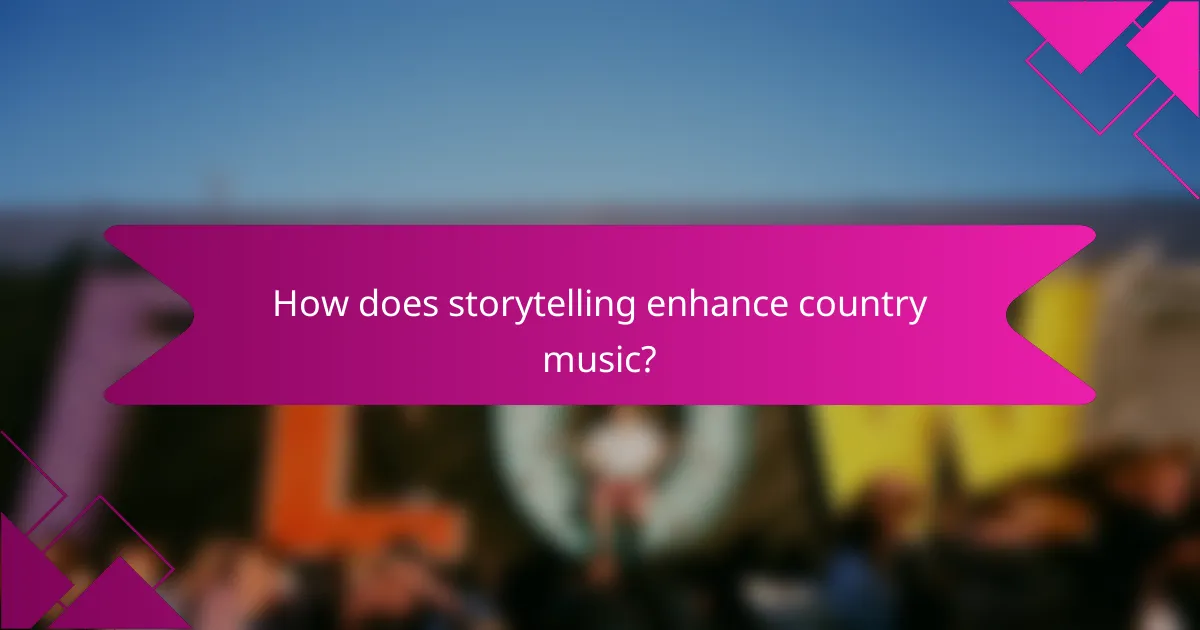Country music is renowned for its storytelling lyrics, which weave personal and relatable narratives that resonate deeply with listeners. The genre’s rich instrumental variety, combining traditional and modern sounds, enhances these stories and broadens its appeal. Rooted in the musical traditions of rural America, country music reflects a diverse cultural heritage that includes influences from folk, blues, and Southern storytelling traditions.

How does storytelling enhance country music?
Storytelling is a fundamental element of country music, enriching the genre by weaving personal and relatable narratives into songs. This approach not only captivates listeners but also fosters a deeper emotional connection with the music.
Emotional connection through narratives
Country music often tells stories that resonate with listeners’ own experiences, creating a strong emotional bond. When artists share personal tales of love, loss, or triumph, it allows fans to see their own lives reflected in the lyrics.
This emotional connection is amplified by the use of vivid imagery and relatable characters, making the stories feel authentic and impactful. As a result, listeners are more likely to engage with the music on a personal level, enhancing their overall experience.
Relatable themes in lyrics
The themes commonly found in country music lyrics, such as heartbreak, family, and perseverance, are universal and relatable. These themes allow listeners from various backgrounds to find common ground and connect with the songs.
By addressing everyday struggles and joys, country music captures the essence of life’s ups and downs, making it accessible to a wide audience. This relatability helps to solidify the genre’s popularity across different demographics.
Examples of iconic storytelling songs
Several country songs exemplify the power of storytelling, showcasing how narratives can resonate with audiences. For instance, “The House That Built Me” by Miranda Lambert tells the story of returning to one’s roots, evoking nostalgia and personal reflection.
Another notable example is “Whiskey Lullaby” by Brad Paisley and Alison Krauss, which explores themes of love and loss through a haunting narrative. These songs highlight the effectiveness of storytelling in conveying deep emotions and connecting with listeners on a profound level.

What instrumental variety is found in country music?
Country music showcases a rich instrumental variety that blends traditional and modern sounds. This diversity enhances storytelling and emotional expression, making the genre appealing to a wide audience.
Use of traditional instruments like banjo and fiddle
Traditional instruments such as the banjo and fiddle are integral to country music, providing its distinctive sound. The banjo contributes a bright, rhythmic quality, while the fiddle adds melodic depth and emotional resonance.
These instruments often feature prominently in bluegrass and folk-infused country styles, creating a connection to the genre’s roots. Many classic country songs highlight these instruments, enriching the storytelling aspect with their unique tones.
Integration of modern instruments like electric guitar
Modern instruments, particularly the electric guitar, have become essential in contemporary country music. The electric guitar allows for a broader range of sounds and effects, enabling artists to explore various musical styles within the genre.
This integration has led to the emergence of subgenres like country rock and pop country, where the electric guitar plays a pivotal role in shaping the overall sound. By blending traditional and modern instruments, country music continues to evolve while maintaining its cultural essence.

What are the cultural roots of country music?
The cultural roots of country music stem from a blend of various musical traditions, particularly those of rural American communities. Its origins can be traced back to the folk music of immigrants, African American blues, and the storytelling traditions of the Southern United States.
Influence of folk music traditions
Folk music traditions play a significant role in shaping country music, as they emphasize storytelling and emotional expression. Instruments like the banjo, fiddle, and guitar, which are common in folk music, have become staples in country music, creating a distinct sound that resonates with audiences.
Additionally, the lyrical content often reflects everyday life, struggles, and joys, drawing from the experiences of ordinary people. This connection to folk roots helps maintain authenticity and relatability in country music, making it a powerful medium for storytelling.
Impact of Southern U.S. culture
The Southern U.S. culture has profoundly influenced country music, infusing it with themes of family, faith, and community. The region’s history, including its agricultural roots and social dynamics, is often reflected in the lyrics and melodies, creating a rich narrative tapestry.
Moreover, Southern culture has introduced various musical styles, such as blues and gospel, which have merged with country music to create diverse subgenres. This cultural amalgamation not only enriches the genre but also highlights the importance of place and identity in the evolution of country music.

How do artists like Dolly Parton shape the genre?
Artists like Dolly Parton significantly shape the country music genre through their unique storytelling, diverse instrumentation, and cultural roots. Parton’s ability to weave personal narratives into her songs has set a standard for authenticity and emotional depth in country music.
Dolly Parton’s storytelling techniques
Dolly Parton is renowned for her vivid storytelling, often drawing from her own life experiences. Her songs frequently feature relatable characters and situations, making them resonate with a wide audience. For example, tracks like “Jolene” and “Coat of Many Colors” illustrate her knack for creating compelling narratives that evoke strong emotions.
Parton employs various literary techniques, such as imagery and dialogue, to enhance her storytelling. By using descriptive language, she paints a picture that allows listeners to visualize the scenes and feel the emotions of the characters. This approach not only captivates her audience but also invites them to reflect on their own experiences.
Influence on female representation in country music
Dolly Parton has played a pivotal role in shaping female representation within the country music genre. As a successful female artist, she has broken barriers and challenged stereotypes, paving the way for future generations of women in music. Her success demonstrates that women can be both commercially viable and artistically respected in a traditionally male-dominated field.
Parton’s image and lyrics often celebrate female empowerment and resilience. By addressing themes such as love, heartbreak, and personal strength, she has inspired countless female artists to express their own stories. This influence is evident in the work of contemporary female country artists who cite her as a major inspiration, further enriching the genre’s diversity and depth.

What role does collaboration play in country music?
Collaboration is essential in country music, enhancing creativity and broadening audience reach. By working together, artists can blend their unique styles and storytelling techniques, resulting in richer musical experiences.
Cross-genre collaborations
Cross-genre collaborations in country music often lead to innovative sounds and increased exposure. For instance, country artists frequently team up with pop, rock, or hip-hop musicians, creating tracks that appeal to diverse audiences. This blending of genres can introduce country music to listeners who might not typically engage with it.
Notable examples include collaborations like Lil Nas X’s “Old Town Road” featuring Billy Ray Cyrus, which topped charts across multiple genres. Such partnerships can significantly boost an artist’s visibility and open doors to new fan bases.
Impact of duets on popularity
Duets in country music can dramatically enhance an artist’s popularity by leveraging the fan bases of both performers. When two well-known artists collaborate, their combined reach can lead to higher streaming numbers and increased radio play. This strategy often results in chart-topping hits that resonate with a wider audience.
For example, the duet “Islands in the Stream” by Kenny Rogers and Dolly Parton remains a classic, showcasing how powerful collaborations can create timeless music. Artists should consider partnering with others to maximize their impact and connect with new listeners.

How can digital platforms enhance country music discovery?
Digital platforms significantly enhance country music discovery by providing easy access to a vast array of songs and artists, allowing listeners to explore diverse styles and stories. These platforms facilitate personalized recommendations and artist engagement, making it simpler for fans to connect with new music and emerging talents.
Streaming services like Spotify and Apple Music
Streaming services such as Spotify and Apple Music play a crucial role in country music discovery by offering curated playlists and algorithm-driven recommendations. Users can explore genres, discover new artists, and listen to popular tracks based on their listening habits.
These platforms often feature exclusive content, including live recordings and interviews, which can deepen listeners’ appreciation for country music. Additionally, many services allow users to create and share their own playlists, fostering community and engagement among fans.
Social media platforms for artist promotion
Social media platforms like Instagram, Facebook, and TikTok are essential for promoting country music artists and their work. Artists can share behind-the-scenes content, engage directly with fans, and showcase their music through short videos and live performances.
These platforms enable artists to build a personal brand and reach a wider audience without the need for traditional marketing. Engaging content, such as challenges or collaborations, can go viral, significantly boosting an artist’s visibility and fanbase.

What are emerging trends in country music?
Emerging trends in country music include a significant blending of genres, particularly with pop and hip-hop influences, as well as a focus on storytelling that resonates with diverse audiences. These trends reflect the genre’s evolution while maintaining its cultural roots.
Blending genres with pop and hip-hop
The blending of country music with pop and hip-hop is reshaping the sound and reach of the genre. Artists are increasingly collaborating across genres, leading to innovative tracks that appeal to a broader audience. This fusion often incorporates catchy hooks, rhythmic beats, and modern production techniques.
For example, songs like “Old Town Road” by Lil Nas X demonstrate how country elements can merge with hip-hop, creating viral hits that dominate charts. This trend encourages country artists to experiment with their sound while attracting new fans who may not typically listen to traditional country music.
When exploring this genre-blending, artists should consider their core audience while being open to experimentation. Collaborations can enhance visibility and create unique sounds, but it’s essential to maintain authenticity to resonate with long-time country fans.
